Rick Steves's Blog, page 62
May 17, 2014
Fine-Tuning Our Tour Program
I’m dedicating three weeks this month to fully experiencing our flagship tour itinerary — The Best of Europe in 21 Days — just as our tour members do. This year, we’re taking over 18,000 travelers on more than 750 Rick Steves tours guided by about a hundred wonderful tour guides. And I feel a responsibility to make sure we offer the maximum experience, fun, and learning for every precious vacation minute and dollar our tour members invest in us.

Our guides learn from each other on the road. We huddle each winter at our annual tour guide summit. And I get to meet up with many of them in Europe. For this tour, my guide is Reid Coen, who can move 25 travelers through the greatest hits of Europe with a stress-free efficiency that gets me all excited as a tour organizer.

Occasionally on this tour, Reid lets me grab the mic. It’s funny how after being a tour guide for 25 years, I can pick up that mic and feel like Alexander Haig (“I am in control here”). Then I come to my senses and take my seat with the other tour members…and let Reid carry on. I really miss tour guiding. But I’m so thankful that we have a team of a hundred guides who routinely exceed our tour members’ very high expectations.
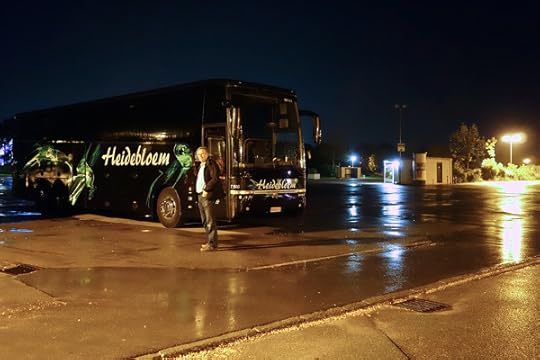
Whenever approaching Germany’s Rothenburg, I have a déjà vu. I remember the stress I felt for two decades of arriving with my bus, hoping to find a place to park. The city is routinely jammed up with tour groups at midday, and very often, there’s no space in the parking lot just outside the city walls. When that happens, the bus needs to park much farther away. And at night, when I pop out to see our bus, it’s the most beautiful sight in all of Europe: our tour bus literally all alone in the parking lot. Why? We’re the only group in town tonight… enjoying the after-dark magic of an otherwise very touristy and congested medieval gem, all to ourselves.
[image error]
My passion as a tour organizer is to have a group of 25 travel as efficiently as a family in a station wagon. And with our well-organized guides, we do. Each day so far on our tour, I’ve marveled at how punctual and mobile our group is — clear communication, packing light, bus standing by, great travelers. Typically, ten minutes after dropping our keys at the hotel desk, we’re having a “buddy check” on the bus and are on the road.
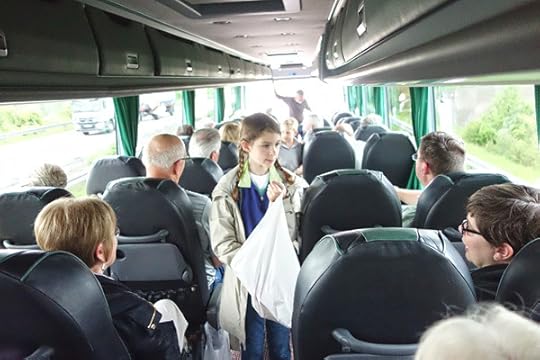
I’ve long been enthusiastic about keeping our tours open to families — providing parents understand that it’s an adult tour and kids can wear out their welcome in a hurry if not parented well. (For years, I’d take my own kids out of school each May for the education of a bus tour through Europe.) On this tour, we have two wonderful kids, and tour guide Reid (ignoring Europe’s child labor laws) enlists them to pass out goodies and tickets on the bus.

On our tours, about half the dinners are included. A favorite part of the meal for me is when the chef and the kitchen staff step out for a round of applause. After a long meal of enjoying local beer or wine, the applause can be particularly raucous.

Evening activities are an important part of any European experience. One of my favorites anywhere is the amazing “Night Watchman Tour” in Rothenburg. Throughout the summer, Georg gives the tour in English each evening at 8:00 p.m. and in German at 9:30 p.m. I’ve taken his tour for two decades now, and I laugh my head off each time. An hour with the Night Watchman is a great way to cap Day Five of our 21-day Best of Europe tour.
May 16, 2014
Inside a Dutch Windmill
Climbing into a working windmill when the wind is strong, I feel the wonder and excitement industrious people must have felt a thousand years ago when the technology to harness wind and water power with mills helped Europe come out of the Dark Ages.
If you can’t see the video below, watch it on YouTube.
Get a better browser!
Walking on Water at Keukenhof
The flower festival at Keukenhof (a treat for any visitor to the Netherlands in May) comes with fun diversions…like this chance to walk on water.
If you can’t see the video below, watch it on YouTube.
Get a better browser!
May 15, 2014
More Tulip Mania at Keukenhof
Any time of year, you’ll enjoy flowers in the Netherlands (as the Dutch are experts in greenhouse technology). But if traveling to Holland in May, be sure to visit Keukenhof, just half an hour south of Amsterdam. The park is well-connected by public transport and a delight even if you think flowers are overrated.
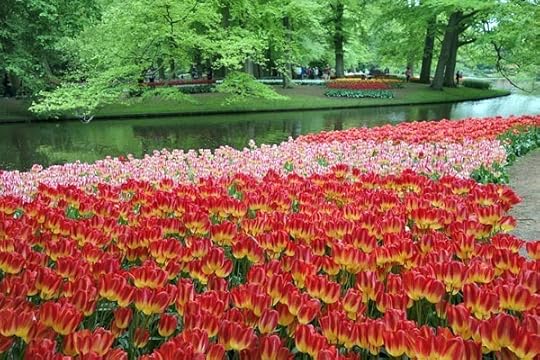
Wandering through Keukenhof, you’ll take piles of photos in search of the most beautiful flower.

I think I have a new screensaver. Centuries ago, diseased bulbs came with wild patterns like these. Today, they are bred to be exotic.
[image error]
The first bulbs were imported from Turkey. In fact, the word “tulip” comes from the turbans — which resembled tulip bulbs — of the merchants who sold them.
Tulip Mania at Keukenhof
We work very hard to flex our tour itineraries in order to take advantage of any special opportunities. In May, our tours in the Netherlands trade a stop at the open-air folk museum in Arnhem for the amazing tulip festival at Keukenhof. The huge park is bursting with color and dotted with Dutch clichés (windmills, wooden shoes, and pancakes).
If you can’t see the video below, watch it on YouTube.
Get a better browser!
May 14, 2014
Tour Time
For 25 years, I led our tour groups. For the past decade, rather than lead our tours, I actually take them. Each year I sign up (with a pseudonym) for one of our tours. In recent years I’ve enjoyed Village Italy, Greece, Turkey, and Scotland. This year, as I paged through our catalog, the right tour for my travel dreams became perfectly clear: our Best of Europe in 21 Days tour.

For the next three weeks, travel with me via this blog on what I consider the best itinerary of what Europe has to offer: Amsterdam, the Rhineland, Rothenburg, Bavarian castles, Venice, Florence, Rome, the Cinque Terre, the Swiss Alps, Burgundy, and Paris. Of the 30 or so tours we offer, this is the granddaddy…the flagship.

For the next three weeks, travel with me via this blog on what I consider the best itinerary of what Europe has to offer: Amsterdam, the Rhineland, Rothenburg, Bavarian castles, Venice, Florence, Rome, the Cinque Terre, the Swiss Alps, Burgundy, and Paris. Of the 30 or so tours we offer, this is the granddaddy…the flagship.

Our bus drivers are an integral part of what makes a Rick Steves tour unique. They are part of the family. And Joe Stulens has driven more than a hundred of our tours.
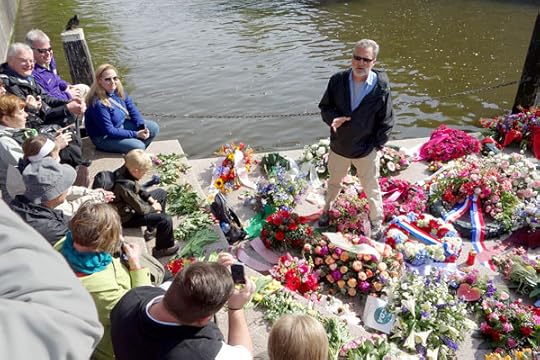
We were in Amsterdam on the Dutch Memorial Day. Throughout Europe, various monuments remind people of the challenges societies have as dense and diverse populations struggle to live peacefully together. Amsterdam’s monument to the homosexual victims of the Holocaust was covered in flowers, providing a fine lectern for our guide, Reid, to give us some historical context.

I’ve long reminded people with serious dietary concerns to print them legibly on a small card, along with a local translation, so they can clearly communicate to waiters what they cannot eat. One of our tour members came well equipped with this card, and will eat better and with more peace of mind because of it.
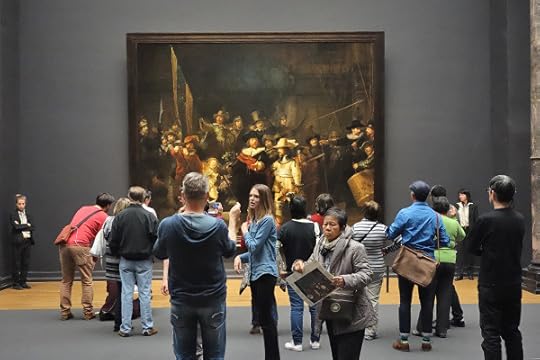
My filming and research lately has taken me to the fringes of Europe. Much as we all like to get off the beaten path, the biggies remain the biggies. This Best of Europe itinerary is all about the biggies, and I’m enjoying revisiting them all. Amsterdam’s Rijksmuseum is newly opened after a long period of renovation. And it is a glorious place to display the very best of Dutch masterpieces…like Rembrandt’s “The Night Watch.”
Bouncing Around Holland’s Polder Land
Exploring polder land with Majel, our Wetlands Safari guide, we learn that the ground is just a mat of vegetation, and below it is the inland sea — and when you throw your weight around, the world becomes your own private trampoline.
If you can’t see the video below, watch it on YouTube.
Get a better browser!
May 13, 2014
Wetlands Safari — Canoeing in Holland
An amazing thing about Amsterdam is that, in 10 minutes (by bike or public bus), you can be in the wide-open polder land — the vast fields reclaimed from the sea where cows graze, tiny canals function as fences, and only church spires interrupt the horizon. A fun way to experience this is by canoe with a local guide. And that’s the mission of Majel Tromp, a friend who runs Wetlands Safari (which I’ve recommended in my guidebook for many years). In a couple of months, I’ll be taking my film crew on a canoe ride with Majel.
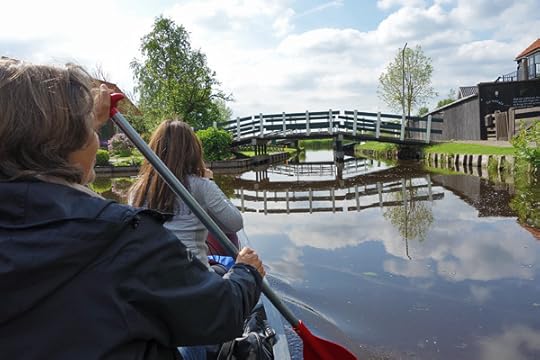
Paddling through villages where front doors face the canal rather than the road is a reminder that there was a time when the main form of transportation in the Netherlands was by boat.

In July, my film crew and I will be on Majel’s tour. So, this month I took her tour to preview what we might shoot. In this natural preserve, the water is shallow. When you stick your oar into the mud and twist you wring bubbles out of the sod: methane — natural gas. (You can smell it.) And, sticking a pole into the ground, you discover the “land” is thin — about a meter thick before you hit the water table underneath.

There’s no dry ground in the polder land, so a Wetlands Safari picnic is always spread out on a plastic sheet.
Bike Band in Haarlem
The TV crew has flown home with two great new shows in the can, and I’m in the Netherlands. How do I know? Where else would you find a “marching band” on bicycles!
If you can’t see the video below, watch it on YouTube.
Get a better browser!
May 12, 2014
Post-Flood Cinque Terre
Two and a half years ago, horrific flash floods buried two of the five Cinque Terre towns in mud. My favorite town, Vernazza, was left uninhabitable for months as the Italian army and emergency workers helped dig it out. I wanted to be sure the Cinque Terre was ready for prime time before we produced our new show on the area — and thankfully, after lots of hard work, it is.
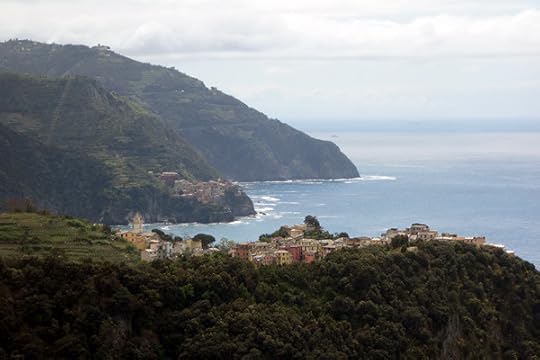
Imagine five wonderfully remote and rustic port towns dotting the most rugged part of the Italian Riviera. Here are two of those towns — each connected by very scenic trails.
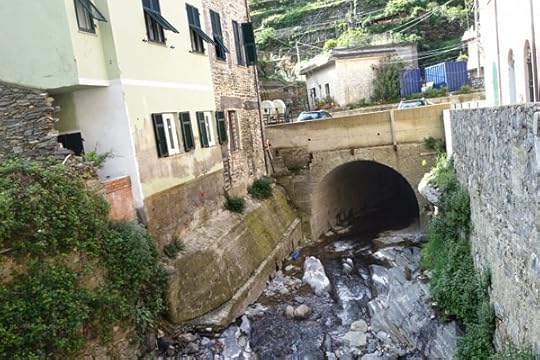
Throughout Europe, there are towns built along ravines where rivers run into lakes or the sea. As their town grows, someone gets the bright idea to pave over the ravine and build a practical main road, rather than a charming but impractical line of little bridges. Vernazza (whose name means “little Venice” in the local dialect, for its many long-gone bridges) was one such town. Generally it’s not a problem, and the stream runs peacefully in a canal under the main drag. But in October 2011, a year’s worth of rain fell in a couple of hours. The steep surrounding hills functioned as a funnel, a wall of water hit the town, and the underground stream got jammed up. The violent torrent washed cars and mud and rocks — anything in reach — through the city and into the sea, and buried every ground floor in mud. Today, Vernazza has made sure its drainage system is ready for violent weather — destructive weather that all the world likely will find routine in the future.
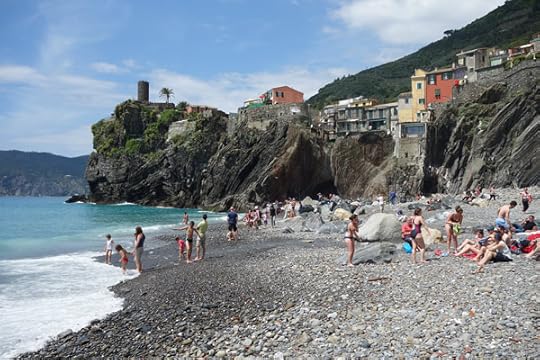
While the flood of 2011 was a disaster that swept several locals out to sea (their bodies actually washed up in France), one benefit of the flood in Vernazza was the creation of this wonderful beach at the edge of town.
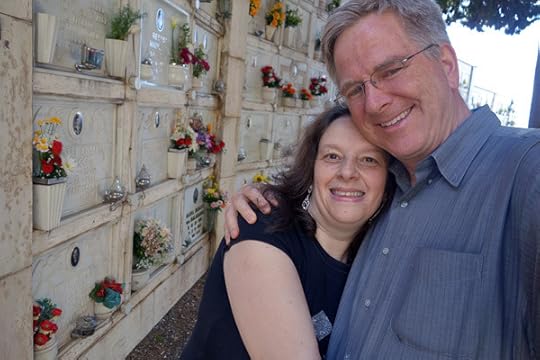
When I first came to the Cinque Terre as a scruffy backpacker, Monica’s father, Lorenzo, befriended me and made me welcome at his restaurant. That was back in the 1970s. Lorenzo is now enjoying an eternal view from a cemetery high above his town, and his daughter Monica, seen here, runs the family restaurant. Twelve years ago, Monica took me to the cemetery overlooking her town, with our cameras rolling. And with this visit she took time out (on the day her restaurant was opening after being closed for the winter) to take us up to the cemetery again. To follow my dear Vernazza friend Monica through her town’s cemetery and hear her remember her departed friends illustrated the beautiful function cemeteries provide.
Rick Steves's Blog
- Rick Steves's profile
- 673 followers



